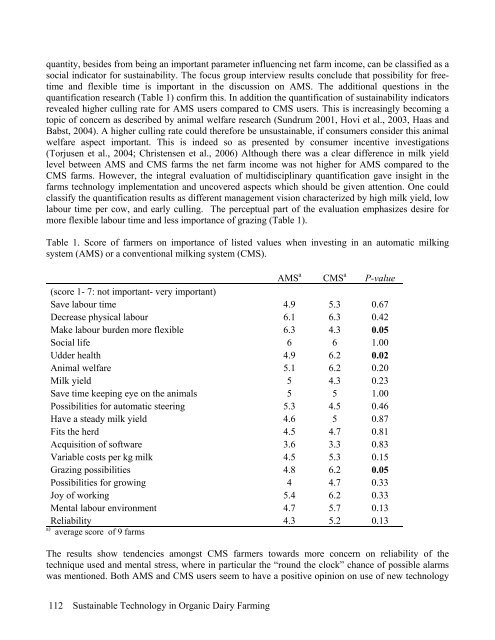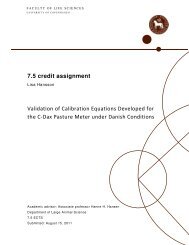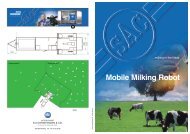Innovative Technology and Sustainable Development of Organic - 1.
Innovative Technology and Sustainable Development of Organic - 1.
Innovative Technology and Sustainable Development of Organic - 1.
You also want an ePaper? Increase the reach of your titles
YUMPU automatically turns print PDFs into web optimized ePapers that Google loves.
quantity, besides from being an important parameter influencing net farm income, can be classified as a<br />
social indicator for sustainability. The focus group interview results conclude that possibility for freetime<br />
<strong>and</strong> flexible time is important in the discussion on AMS. The additional questions in the<br />
quantification research (Table 1) confirm this. In addition the quantification <strong>of</strong> sustainability indicators<br />
revealed higher culling rate for AMS users compared to CMS users. This is increasingly becoming a<br />
topic <strong>of</strong> concern as described by animal welfare research (Sundrum 2001, Hovi et al., 2003, Haas <strong>and</strong><br />
Babst, 2004). A higher culling rate could therefore be unsustainable, if consumers consider this animal<br />
welfare aspect important. This is indeed so as presented by consumer incentive investigations<br />
(Torjusen et al., 2004; Christensen et al., 2006) Although there was a clear difference in milk yield<br />
level between AMS <strong>and</strong> CMS farms the net farm income was not higher for AMS compared to the<br />
CMS farms. However, the integral evaluation <strong>of</strong> multidisciplinary quantification gave insight in the<br />
farms technology implementation <strong>and</strong> uncovered aspects which should be given attention. One could<br />
classify the quantification results as different management vision characterized by high milk yield, low<br />
labour time per cow, <strong>and</strong> early culling. The perceptual part <strong>of</strong> the evaluation emphasizes desire for<br />
more flexible labour time <strong>and</strong> less importance <strong>of</strong> grazing (Table 1).<br />
Table <strong>1.</strong> Score <strong>of</strong> farmers on importance <strong>of</strong> listed values when investing in an automatic milking<br />
system (AMS) or a conventional milking system (CMS).<br />
AMS a<br />
CMS a<br />
P-value<br />
(score 1- 7: not important- very important)<br />
Save labour time 4.9 5.3 0.67<br />
Decrease physical labour 6.1 6.3 0.42<br />
Make labour burden more flexible 6.3 4.3 0.05<br />
Social life 6 6 <strong>1.</strong>00<br />
Udder health 4.9 6.2 0.02<br />
Animal welfare 5.1 6.2 0.20<br />
Milk yield 5 4.3 0.23<br />
Save time keeping eye on the animals 5 5 <strong>1.</strong>00<br />
Possibilities for automatic steering 5.3 4.5 0.46<br />
Have a steady milk yield 4.6 5 0.87<br />
Fits the herd 4.5 4.7 0.81<br />
Acquisition <strong>of</strong> s<strong>of</strong>tware 3.6 3.3 0.83<br />
Variable costs per kg milk 4.5 5.3 0.15<br />
Grazing possibilities 4.8 6.2 0.05<br />
Possibilities for growing 4 4.7 0.33<br />
Joy <strong>of</strong> working 5.4 6.2 0.33<br />
Mental labour environment 4.7 5.7 0.13<br />
Reliability<br />
a)<br />
average score <strong>of</strong> 9 farms<br />
4.3 5.2 0.13<br />
The results show tendencies amongst CMS farmers towards more concern on reliability <strong>of</strong> the<br />
technique used <strong>and</strong> mental stress, where in particular the “round the clock” chance <strong>of</strong> possible alarms<br />
was mentioned. Both AMS <strong>and</strong> CMS users seem to have a positive opinion on use <strong>of</strong> new technology<br />
112 <strong>Sustainable</strong> <strong>Technology</strong> in <strong>Organic</strong> Dairy Farming




